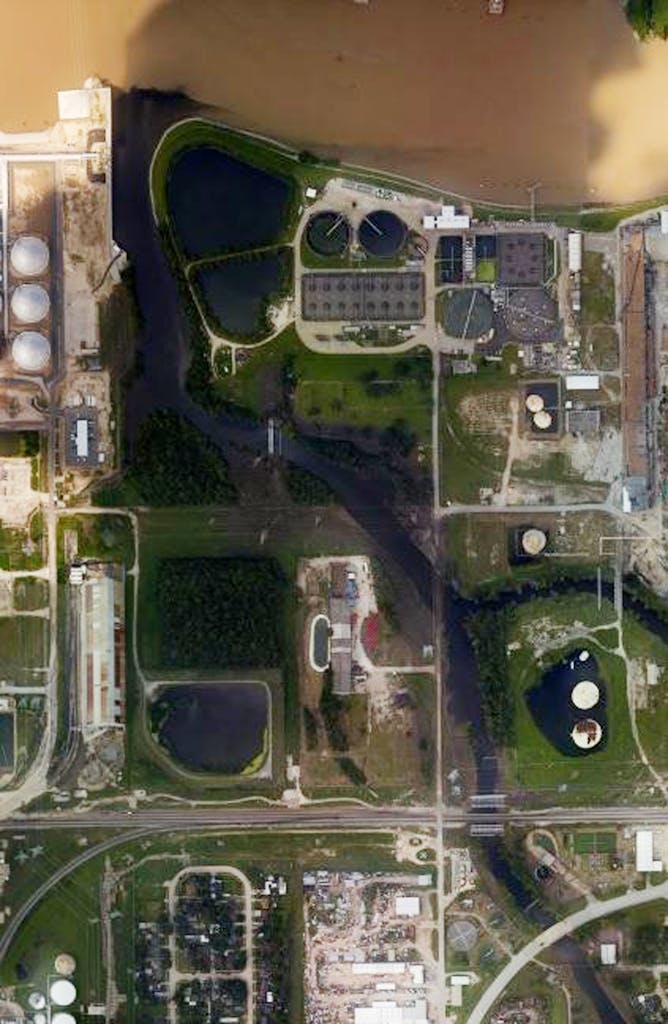This article has been updated. It originally stated that the three spills at the Superfund site went unreported for weeks. PRP Group, the organization supervising the cleanup at U.S. Oil Recovery, reported the spills to the government. We regret the error.
One of Houston’s dirtiest Superfund toxic waste sites experienced three spills in the days after the torrential rain from Hurricane Harvey. But, as has been the case with other toxic spills resulting from Harvey, details of the spills were not available to the public for weeks, until the Associated Press got a look at some aerial photos that showed dark-colored water surrounding the site as the floodwater receded. The dark water was shown flowing through Vince Bayou and into the Houston Ship Channel.

The AP first reported the spills earlier this week; the Environmental Protection Agency has not publicly acknowledged them. The agency told the AP that it sent an on-scene coordinator to the Superfund site Wednesday last week, but found no evidence that material had washed off the site though they are still assessing the scene at U.S. Oil Recovery, a former petroleum-industry waste-processing plant contaminated with “a dangerous brew of cancer-causing chemicals,” according to the AP.
A county pollution control team had sent photos to the EPA of three large concrete tanks flooded with water on August 29, after the Harvey floodwater had cleared out. And PRP Group, a company overseeing cleanup at the Superfund site, reported the spill via a federal emergency hotline operated by the U.S. Coast Guard. The company reported two more spills of potentially contaminated storm water from the site.
The U.S. Oil Recovery Site has a pretty bizarre history, according to the AP. It was shut down in 2010 after regulators found it posed an environmental threat to Vince Bayou. Pollution at the plant was so bad that, in 2013, the company’s owner, Klaus Genssler, was charged with five criminal felonies by Texas prosecutors. But the German native fled the United States, and is now considered a fugitive. More than 100 companies, including Baker Hughes, U.S. Steel Corp. and Dow Chemical, that had originally directed their hazardous waste to U.S. Oil Recovery to be processed, are now pitching in to pay for the multimillion-dollar cleanup through a court-monitored settlement. Workers have have removed more than 1.5 million gallons of liquid waste from the Superfund site, which is enough to fill nearly three Olympic-sized swimming pools. According to the AP, the southern portion of the site, including the three waste tanks that flooded during Harvey, has yet to be fully cleaned.
This is at least the third high-profile chemical disaster to come to light since Harvey. The EPA is currently investigating whether Arkema followed safety rules at its plant in Crosby. Chemical containers exploded at the site and were on fire for days when the facility sustained damage during flooding. A group of first responders and homeowners have also filed a lawsuit against Arkema, seeking damages after they were sickened following exposure to chemicals. Floodwaters also triggered a massive spill near Houston’s Galena Park neighborhood, where a Magellan Midstream Partners facility leaked 11,000 barrels—or 460,000 gallons—of gasoline. And in the days after Harvey, the AP reported that at least seven Superfund sites in and around Houston were inundated with water, not including the U.S. Oil Recovery site, while Reuters reported earlier this month that the Coast Guard and the EPA were working with Texas state regulators to clean up spills at a dozen industrial facilities.
- More About:
- Energy
- Hurricane Harvey






